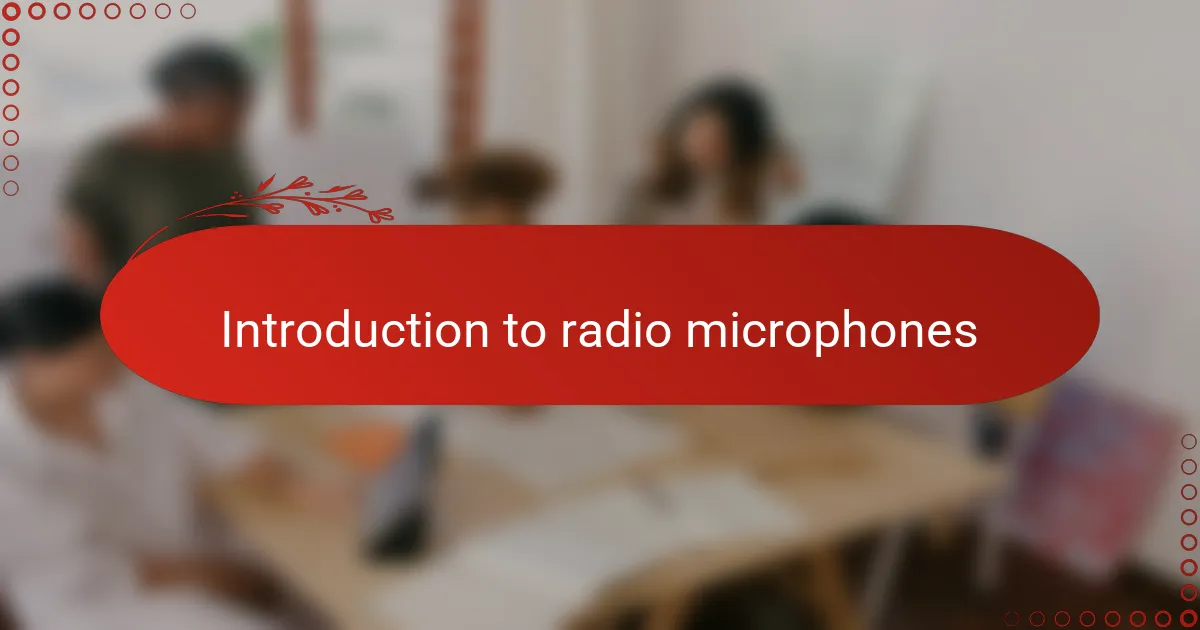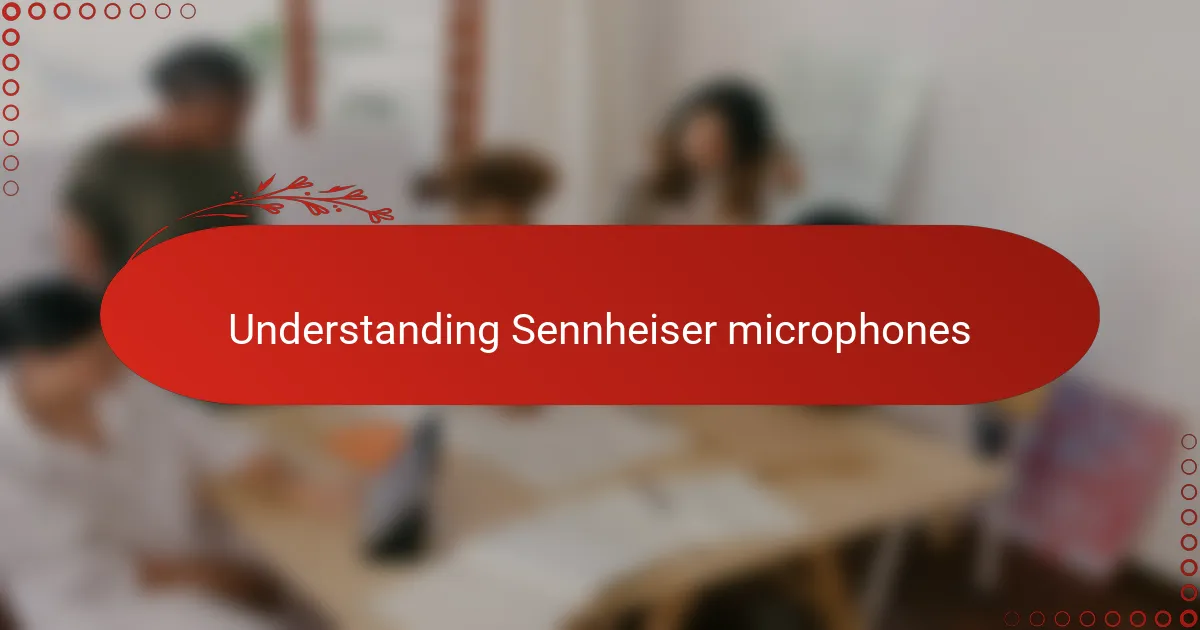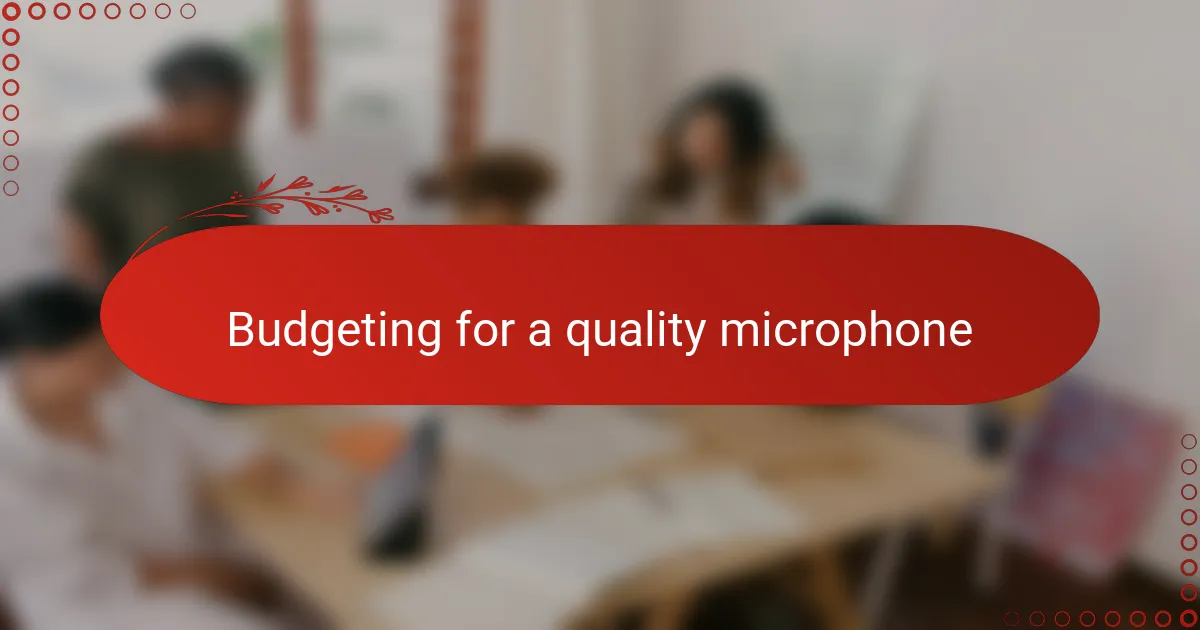Key takeaways
- Radio microphones, especially high-quality ones like Sennheiser, significantly enhance broadcast sound quality and immersion.
- Choosing the right microphone involves understanding personal needs, the broadcast environment, and technical specifications such as pickup patterns.
- Budgeting for a quality microphone requires balancing essential features and long-term investment, prioritizing clarity and durability.
- Researching various models and consulting others can provide valuable insights, leading to informed purchasing decisions.

Introduction to radio microphones
Radio microphones are the unsung heroes of every live broadcast, capturing voices with clarity and precision even in the most challenging environments. I remember the first time I realized just how crucial a good mic was; the difference in sound quality instantly changed the entire vibe of my show. Have you ever wondered why some broadcasts feel so immersive and others fall flat? Often, it comes down to the microphone.

Understanding Sennheiser microphones
When I first started exploring Sennheiser microphones, I was struck by their reputation for durability and sound quality. These mics aren’t just gadgets; they’re tools built to capture every nuance, which is something I learned the hard way after struggling with cheaper alternatives. Have you ever noticed how some voices come through with warmth and detail, while others sound flat? That’s the magic of a well-engineered microphone.
What I found fascinating about Sennheiser is how they cater to different needs in broadcasting. From dynamic to condenser microphones, each model serves a specific purpose. I remember debating which type would suit my radio show best and realizing that understanding these differences was crucial to getting the sound I wanted.
Another thing that stood out to me was the lore behind the brand—decades of innovation and a commitment to crystal-clear audio. It made me feel like I was investing not just in a mic, but a legacy of quality that would support my broadcasts for years. Don’t you think it’s reassuring to hold something in your hand that professionals worldwide trust every day?

Choosing the right mic for broadcasting
Choosing the right mic for broadcasting felt like navigating a maze at first. I asked myself, should I go for a dynamic mic that handles loud sounds well, or a condenser mic that picks up more detail? It wasn’t just about specs; it was about how I wanted my voice to connect with listeners.
What really helped me decide was imagining the environment where I’d be broadcasting. Would I be in a noisy studio or somewhere quieter? I realized that understanding the mic’s pickup pattern—how it captures sound from different directions—was a game changer. This insight made the choice feel less overwhelming.
Have you ever held a mic and felt that moment of clarity when everything just clicks? That was my experience with the Sennheiser. It was like the mic was designed to work with my voice, not against it. Choosing the right mic isn’t just technical; it’s deeply personal.

Budgeting for a quality microphone
Budgeting for a quality microphone wasn’t as straightforward as I initially thought. I had to balance my desire for top-tier sound with the reality of my wallet, which felt like a tug-of-war between passion and practicality. Have you ever stared at a price tag, wondering if the investment would truly pay off in the long run? That was me—hesitant yet hopeful.
I remember making a list of must-haves versus nice-to-haves to keep my budget on track. Prioritizing essential features like durability and audio clarity made me realize that spending a bit more upfront could save money—and frustration—later. It felt like choosing quality over quantity, something I wish I had done sooner in my broadcasting journey.
In the end, I treated budgeting like planning for a relationship—not just a purchase. Investing in a Sennheiser mic meant committing to better sound and a tool that would grow with me. Isn’t that what we all want from our gear? Something reliable that understands our voice and evolves with our craft.

Researching Sennheiser models
Researching Sennheiser models opened my eyes to just how vast their lineup truly is. I found myself scrolling through endless specifications, each mic promising something slightly different—whether it was enhanced clarity, ruggedness, or wireless capabilities. Have you ever felt overwhelmed by choice, yet excited by the possibilities? That’s exactly where I was.
What struck me most during my research was how each model seemed tailored to a specific broadcasting need. For instance, some were perfect for on-the-go reporters, while others shone in studio settings with rich, detailed sound. I realized that knowing the environment I’d be working in made the decision much clearer.
Digging deeper, I also came across user reviews and professional opinions, which helped me separate marketing hype from real performance. Reading those firsthand experiences made me feel more confident, almost like having a conversation with fellow broadcasters who had already walked this path. Isn’t it reassuring to learn from others’ journeys before making your own?

My buying experience and process
The actual buying process felt surprisingly empowering once I had done my homework. I recall visiting a local audio store, microphone in mind, and instantly feeling that mix of excitement and nerves—would this mic live up to my expectations? Handling the Sennheiser right there, I remember the weight and solid build giving me a quiet confidence.
I asked the sales expert a lot of questions, probing about warranty and performance in different settings, because I wanted to be sure this purchase wasn’t just impulsive but a smart, long-term investment. Have you ever had that moment where a salesperson really listens and helps you think through your options rather than just pushing the most expensive choice? That made a huge difference for me.
Once I got home, setting up the mic was almost a ritual, filled with anticipation. I kept testing my voice and tweaking settings, realizing that buying the mic was only the start of a relationship I hoped would elevate every broadcast. Isn’t it fascinating how a piece of equipment can feel like a partner in your creative work?

Tips for first-time mic buyers
One of the first things I learned is to trust your ears more than the specs on paper. When I auditioned my Sennheiser mic, the sound it captured in real conditions mattered way more than any technical sheet. Have you ever noticed how sometimes the numbers don’t tell the full story? That hands-on feeling made all the difference for me.
Another tip I swear by is to consider how you’ll actually use the mic day-to-day. When I thought about the types of broadcasts I’d do—whether interviews or solo shows—it shaped my choice profoundly. Have you ever bought gear that looked great but didn’t quite fit your routine? Avoiding that mismatch can save you a lot of frustration.
Lastly, don’t shy away from asking questions—seriously, ask away, whether it’s to salespeople or fellow broadcasters. I remember how much clearer things became after chatting deeply about mic durability and handling. Isn’t it comforting to know you’re not alone in sorting through the noise? Those conversations gave me confidence that I was making the right call.
